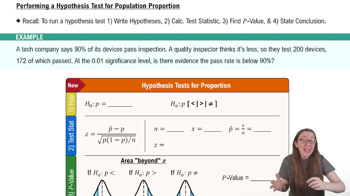Explain why the Kruskal-Wallis test is always a right-tailed test.
Table of contents
- 1. Intro to Stats and Collecting Data1h 14m
- 2. Describing Data with Tables and Graphs1h 55m
- 3. Describing Data Numerically2h 5m
- 4. Probability2h 16m
- 5. Binomial Distribution & Discrete Random Variables3h 6m
- 6. Normal Distribution and Continuous Random Variables2h 11m
- 7. Sampling Distributions & Confidence Intervals: Mean3h 23m
- Sampling Distribution of the Sample Mean and Central Limit Theorem19m
- Distribution of Sample Mean - Excel23m
- Introduction to Confidence Intervals15m
- Confidence Intervals for Population Mean1h 18m
- Determining the Minimum Sample Size Required12m
- Finding Probabilities and T Critical Values - Excel28m
- Confidence Intervals for Population Means - Excel25m
- 8. Sampling Distributions & Confidence Intervals: Proportion1h 25m
- 9. Hypothesis Testing for One Sample3h 57m
- 10. Hypothesis Testing for Two Samples4h 50m
- Two Proportions1h 13m
- Two Proportions Hypothesis Test - Excel28m
- Two Means - Unknown, Unequal Variance1h 3m
- Two Means - Unknown Variances Hypothesis Test - Excel12m
- Two Means - Unknown, Equal Variance15m
- Two Means - Unknown, Equal Variances Hypothesis Test - Excel9m
- Two Means - Known Variance12m
- Two Means - Sigma Known Hypothesis Test - Excel21m
- Two Means - Matched Pairs (Dependent Samples)42m
- Matched Pairs Hypothesis Test - Excel12m
- 11. Correlation1h 24m
- 12. Regression1h 50m
- 13. Chi-Square Tests & Goodness of Fit2h 21m
- 14. ANOVA1h 57m
9. Hypothesis Testing for One Sample
Steps in Hypothesis Testing
Problem 11.5.15e
Textbook Question
Performing a Runs Test In Exercises 15 – 20, (e) interpret the decision in the context of the original claim. Use α = 0.05
Coin Toss A coach records the results of the coin toss at the beginning of each football game for a season. The results are shown, where H represents heads and T represents tails. The coach claimed the tosses were not random. Test the coach’s claim.
H T T T H T H H T T T T H T H H
 Verified step by step guidance
Verified step by step guidance1
Step 1: Understand the Runs Test. The Runs Test is a non-parametric test used to determine if a sequence of data points is random. A 'run' is a sequence of similar outcomes (e.g., consecutive H's or T's). The null hypothesis (H₀) assumes the sequence is random, while the alternative hypothesis (H₁) assumes the sequence is not random.
Step 2: Identify the sequence and count the number of runs. In the given sequence (H T T T H T H H T T T T H T H H), identify each run of consecutive H's or T's. For example, the first run is 'H', the second run is 'T T T', and so on. Count the total number of runs in the sequence.
Step 3: Calculate the expected number of runs under the null hypothesis. Use the formula for the expected number of runs (E[R]) in a sequence of two categories: , where is the number of H's, is the number of T's, and is the total number of observations.
Step 4: Calculate the standard deviation of the number of runs. Use the formula for the standard deviation (σ[R]): . This will help determine the z-score for the observed number of runs.
Step 5: Perform the hypothesis test. Compute the z-score using the formula , where R is the observed number of runs. Compare the z-score to the critical value for a two-tailed test at α = 0.05 (±1.96). If the z-score falls outside this range, reject the null hypothesis and conclude that the sequence is not random. Otherwise, fail to reject the null hypothesis.
 Verified video answer for a similar problem:
Verified video answer for a similar problem:This video solution was recommended by our tutors as helpful for the problem above
Video duration:
2mPlay a video:
Was this helpful?
Key Concepts
Here are the essential concepts you must grasp in order to answer the question correctly.
Runs Test
The Runs Test is a non-parametric statistical test used to determine the randomness of a sequence of data points. It analyzes the occurrence of 'runs,' which are sequences of consecutive identical elements, to assess whether the observed pattern deviates from what would be expected in a random sequence. In this context, it helps evaluate the coach's claim about the randomness of coin toss results.
Recommended video:
Guided course

Independence Test
Hypothesis Testing
Hypothesis testing is a statistical method that uses sample data to evaluate a hypothesis about a population parameter. It involves formulating a null hypothesis (H0) and an alternative hypothesis (H1), then using a significance level (α) to determine whether to reject H0. In this case, the null hypothesis would state that the coin tosses are random, while the alternative would support the coach's claim of non-randomness.
Recommended video:

Performing Hypothesis Tests: Proportions
Significance Level (α)
The significance level, denoted as α, is the threshold for determining whether the results of a statistical test are statistically significant. Commonly set at 0.05, it represents a 5% risk of concluding that a difference exists when there is none (Type I error). In this scenario, using α = 0.05 means that if the p-value from the Runs Test is less than 0.05, the coach's claim of non-randomness would be supported.
Recommended video:

Finding Binomial Probabilities Using TI-84 Example 1

 5:12m
5:12mWatch next
Master Intro to Hypothesis Testing with a bite sized video explanation from Patrick
Start learningRelated Videos
Related Practice
Textbook Question
47
views
